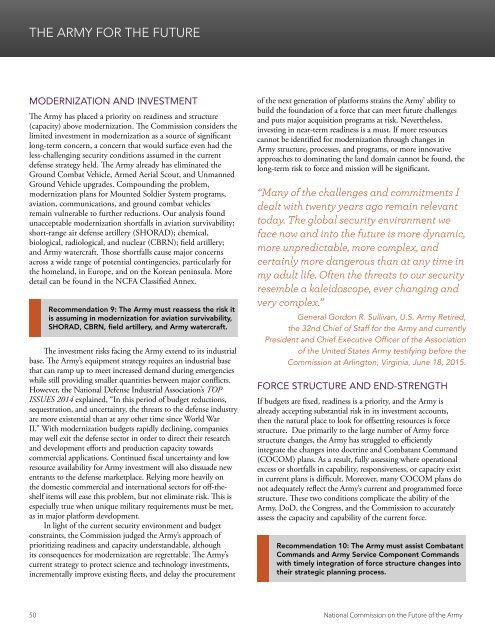THE FUTURE OF THE ARMY
NCFA_Full%20Final%20Report_0
NCFA_Full%20Final%20Report_0
You also want an ePaper? Increase the reach of your titles
YUMPU automatically turns print PDFs into web optimized ePapers that Google loves.
<strong>THE</strong> <strong>ARMY</strong> FOR <strong>THE</strong> <strong>FUTURE</strong><br />
MODERNIZATION AND INVESTMENT<br />
The Army has placed a priority on readiness and structure<br />
(capacity) above modernization. The Commission considers the<br />
limited investment in modernization as a source of significant<br />
long-term concern, a concern that would surface even had the<br />
less-challenging security conditions assumed in the current<br />
defense strategy held. The Army already has eliminated the<br />
Ground Combat Vehicle, Armed Aerial Scout, and Unmanned<br />
Ground Vehicle upgrades. Compounding the problem,<br />
modernization plans for Mounted Soldier System programs,<br />
aviation, communications, and ground combat vehicles<br />
remain vulnerable to further reductions. Our analysis found<br />
unacceptable modernization shortfalls in aviation survivability;<br />
short-range air defense artillery (SHORAD); chemical,<br />
biological, radiological, and nuclear (CBRN); field artillery;<br />
and Army watercraft. Those shortfalls cause major concerns<br />
across a wide range of potential contingencies, particularly for<br />
the homeland, in Europe, and on the Korean peninsula. More<br />
detail can be found in the NCFA Classified Annex.<br />
Recommendation 9: The Army must reassess the risk it<br />
is assuming in modernization for aviation survivability,<br />
SHORAD, CBRN, field artillery, and Army watercraft.<br />
The investment risks facing the Army extend to its industrial<br />
base. The Army’s equipment strategy requires an industrial base<br />
that can ramp up to meet increased demand during emergencies<br />
while still providing smaller quantities between major conflicts.<br />
However, the National Defense Industrial Association’s TOP<br />
ISSUES 2014 explained, “In this period of budget reductions,<br />
sequestration, and uncertainty, the threats to the defense industry<br />
are more existential than at any other time since World War<br />
II.” With modernization budgets rapidly declining, companies<br />
may well exit the defense sector in order to direct their research<br />
and development efforts and production capacity towards<br />
commercial applications. Continued fiscal uncertainty and low<br />
resource availability for Army investment will also dissuade new<br />
entrants to the defense marketplace. Relying more heavily on<br />
the domestic commercial and international sectors for off-theshelf<br />
items will ease this problem, but not eliminate risk. This is<br />
especially true when unique military requirements must be met,<br />
as in major platform development.<br />
In light of the current security environment and budget<br />
constraints, the Commission judged the Army’s approach of<br />
prioritizing readiness and capacity understandable, although<br />
its consequences for modernization are regrettable. The Army’s<br />
current strategy to protect science and technology investments,<br />
incrementally improve existing fleets, and delay the procurement<br />
of the next generation of platforms strains the Army’ ability to<br />
build the foundation of a force that can meet future challenges<br />
and puts major acquisition programs at risk. Nevertheless,<br />
investing in near-term readiness is a must. If more resources<br />
cannot be identified for modernization through changes in<br />
Army structure, processes, and programs, or more innovative<br />
approaches to dominating the land domain cannot be found, the<br />
long-term risk to force and mission will be significant.<br />
“Many of the challenges and commitments I<br />
dealt with twenty years ago remain relevant<br />
today. The global security environment we<br />
face now and into the future is more dynamic,<br />
more unpredictable, more complex, and<br />
certainly more dangerous than at any time in<br />
my adult life. Often the threats to our security<br />
resemble a kaleidoscope, ever changing and<br />
very complex.”<br />
General Gordon R. Sullivan, U.S. Army Retired,<br />
the 32nd Chief of Staff for the Army and currently<br />
President and Chief Executive Officer of the Association<br />
of the United States Army testifying before the<br />
Commission at Arlington, Virginia, June 18, 2015.<br />
FORCE STRUCTURE AND END-STRENGTH<br />
If budgets are fixed, readiness is a priority, and the Army is<br />
already accepting substantial risk in its investment accounts,<br />
then the natural place to look for offsetting resources is force<br />
structure. Due primarily to the large number of Army force<br />
structure changes, the Army has struggled to efficiently<br />
integrate the changes into doctrine and Combatant Command<br />
(COCOM) plans. As a result, fully assessing where operational<br />
excess or shortfalls in capability, responsiveness, or capacity exist<br />
in current plans is difficult. Moreover, many COCOM plans do<br />
not adequately reflect the Army’s current and programmed force<br />
structure. These two conditions complicate the ability of the<br />
Army, DoD, the Congress, and the Commission to accurately<br />
assess the capacity and capability of the current force.<br />
Recommendation 10: The Army must assist Combatant<br />
Commands and Army Service Component Commands<br />
with timely integration of force structure changes into<br />
their strategic planning process.<br />
50 National Commission on the Future of the Army


